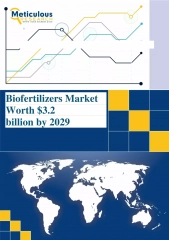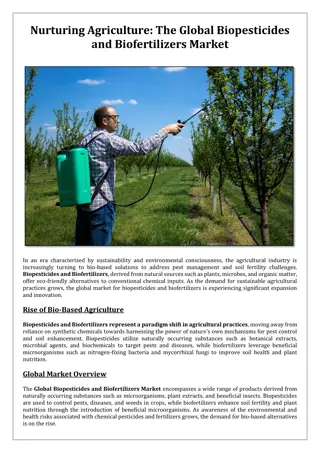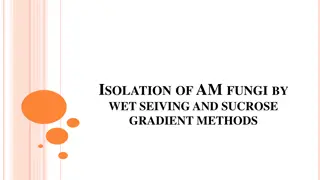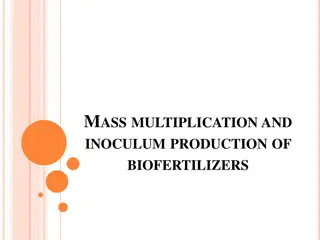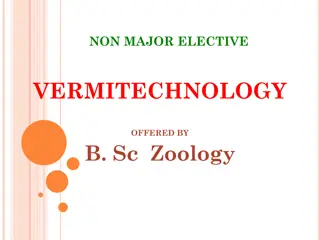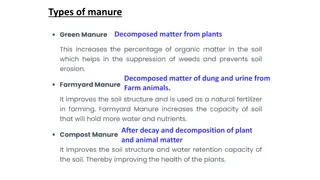Global biofertilizer market- Emerging trends and opportunities
The global biofertilizers market is segmented by microorganism type (nitrogen-fixing microbes, phosphate solubilizing & mobilizing microbes, potassium solubilizing & mobilizing microbes, other microorganism types), crop type (cereals & grains, oilseeds & pulses, fruits & vegetables, other crop types
1 views • 4 slides
Understanding Biofertilizers: Production Technology and Types
Biofertilizers are natural microbial inoculants that provide nutrients to crop plants, improve soil health, and promote sustainable agriculture. Learn about the production technology, benefits, and types of biofertilizers including bacterial, fungal, algal, and aquatic fern biofertilizers. Explore h
5 views • 13 slides
Nurturing Agriculture: The Global Biopesticides and Biofertilizers Market
According to the BIS Research Report, the Biopesticides and Biofertilizers Market was valued at $6,906.7 million in 2023, and it is expected to grow at a CAGR of 12.52% and reach $22,463.3 million by 2033 during the forecast period 2023-2033.
4 views • 3 slides
Isolation of AM Fungi by Wet Sieving and Sucrose Gradient Methods
Wet sieving is a popular technique to isolate different sizes of spores from soil samples. Developed by Gerdemann and Nicolson in 1963, this method involves passing an aqueous suspension through different sieves to collect spores of varying sizes. The process includes agitating the soil-water mixtur
0 views • 14 slides
Understanding Biofertilizers for Sustainable Agriculture
Biofertilizers, containing living microorganisms, enhance plant growth by improving nutrient availability. This eco-friendly alternative to traditional fertilizers offers promising results, especially in dry environments. Research shows mycorrhizal fungi play a key role in plant health and crop yiel
0 views • 9 slides
Biofertilizers: Multiplication, Types, Advantages, and Applications
Biofertilizers play a crucial role in agriculture by harnessing live microbes to enhance soil fertility. They fix atmospheric nitrogen, solubilize phosphorus, and decompose organic wastes. Various types of biofertilizers exist, including carrier-based and liquid forms, each with its own advantages a
0 views • 18 slides
Vermitechnology and Composting: Sustainable Waste Management Solutions
Solid waste management is crucial in the face of increasing urbanization. Composting and vermitechnology offer natural and effective ways to treat organic waste, with earthworms playing a key role in bioconversion processes. Utilizing organic wastes like animal manure, crop residues, and food waste,
1 views • 12 slides
Importance of Biofertilizer in Agriculture
Biofertilizers containing living microorganisms promote plant growth by enhancing nutrient availability. Blue-green algae, a type of biofertilizer, can fix atmospheric nitrogen to benefit crops. In agriculture, biofertilizers can help reduce chemical fertilizer use, restore soil health, and increase
0 views • 17 slides
Understanding Biofertilizers and Their Role in Sustainable Agriculture
Biofertilizers contain living microorganisms that promote plant growth by enhancing nutrient availability. Unlike conventional fertilizers, biofertilizers work through natural processes like nitrogen fixation and phosphorus solubilization. Research shows how mycorrhizal fungi can improve crop yield
0 views • 9 slides
A Comprehensive Guide to Fertilizers and Manure for Agriculture
Explore the various types of manure, nutrients in fertilizers, organic and inorganic fertilizers, biofertilizers, pond fertilization techniques, and factors influencing proper pond fertilization. Learn about different types of fertilizers used for pond fertilization, including solid fertilizers. Enh
0 views • 17 slides
